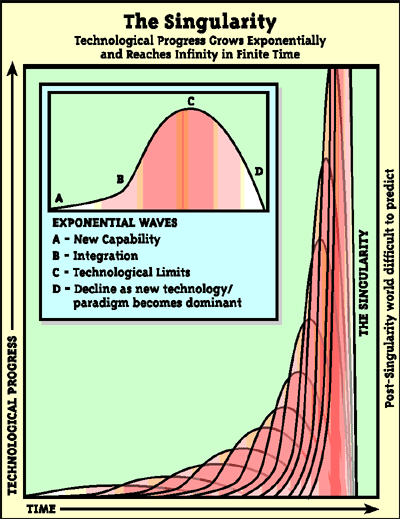Among other things I am a self-proclaimed science- and science fiction nerd. I love Ray Bradbury, Aldous Huxley, and H.P. Lovecraft. Carl Sagan and Stephen Hawking are my heroes. While I’m not geeking out to Sci-Fi and dystopian literature or looking at the new Hubble Space Telescope pictures, from time to time think about technology in terms of the singularity. I felt it would be fun to write a blog post about it from an Anthropological perspective. I’ll try to stay grounded for this one and not get too far out into the ether….
First things first, what is a singularity?
In physics, a singularity is defined as a point at which a function takes an infinite value. For example, a singularity exists in space-time when matter is infinitely dense as in the center of a black hole.
In technology, the singularity describes a point in time at which the scientific and technological rules of civilization are incomprehensible to previous generations, a concept coined by mathematician John Van Neumann in the 1950’s. The concept was popularized by science fiction writer Verner Vinge, who associated it with the development of artificial intelligence beyond that of the human brain. This doesn’t mean that it’s impossible; I just don’t see any Hal-computers or Matrix machines in our near future. Sure, computers can calculate complex problems faster than we can do them in our head, but computers don't have the spectrum of human emotion nor human creativity. The A.I. element of the singularity is a little far fetched right now, but the singularity without A.I. is still a valid model for how humans interact with technology. The take-away is that technology, especially computing technology- is evolving at an exponential rate such that we can't possibly predict future innovation. It is more vital than ever that we anticipate the effect of technology on human culture and well-being. And that is why we need Anthropologists, to anticipate the needs of people and the human element.

http://theadvancedapes.com/wp-content/uploads/2013/05/cadelllast_24600221320536_small.jpg
Let’s take stock of the singularity as describing what we can observe in history. I like to think of it like a series of waves at sea that are large and rolling, and become tighter and higher once they reach shore. Hypothetically, then, multiple singularities have occurred during human history since homo sapien began using technology to manipulate the world around them.
Continuing with the waves at sea model, the large waves are important foundation technologies such as the harnessing of fire, and the invention of the wheel. Waves increase in frequency and height as foundation inventions pave the way for a myriad of innovations and progress. What happens when the wave reaches the shore? A “crash” or what I like to think of as a plateau occurs as a new technology becomes dominant or widespread, creating a paradigm shift. For how long will the plateau last until a new paradigm is introduced? It’s difficult to say.

http://www.mindfully.org/Technology/2003/Singularity-Bell1may03.GIF
-This graphic is based on Tom McKendree's 1994 singularity diagram for Hughes Aircraft, explaining anticipated affects of technology on warfare.
I like this diagram because it demonstrates the law of accelerating returns- each technological advancement increases the limits of capability for the next capability, and so on. The effect is exponential growth, but they are exponential waves. The larger pattern is exponential but each wave is unique- the length and height of each varies depending on a variety of factors- culture, for one.
http://artsnap.org/wp-content/uploads/2010/02/Screen-Shot-2012-05-23-at-10.44.25-PM.png
Michaelangelo's David, sculpted 1504
Take the example of the Italian Renaissance in the 14th Century. Nostalgia for Classical Antiquity prompted a subtle, more anatomically accurate representation of the human form in art and sculpture. Michelangelo's David is perhaps the most well known of these new masterpieces. Most importantly, resurgence of Classical history and philosophy prompted Renaissance humanism, which put emphasis on the Aristotelian and Ptolemaic views of the Universe as opposed to a Christian view. Ultimately, humanists rejected Aristotle's Geocentric Universe in favor of the heliocentric model of Copernicus. This paradigm shift in philosophy ultimately paved the way for great advancements in natural science and medicine, culminating in the Age of Enlightenment. The lull in advancement of science in Medieval Europe represents a dip in the pattern of technological innovation although essentially isolated to Europe. We are only human. But are we more than human animals?
The singularity implies that humans have transcended their biology. I think it’s safe to say that most people would agree that we as humans have done this already, in a sense. American Archaeologist Lewis Binford said that “culture is man’s extrasomatic means of adaptation.” Today, culture is so integrated with technology that often they are interchangeable. We have complex shelters with essentially self-sustaining systems, we have cars, boats, and planes for transportation, phones and computers for communication. Infrastructures are maintained with technologies that we have created and streamlined for efficiency and comfort. We don’t have to build a fire to eat or stay warm, we don’t have to hunt or gather our food, and for the most part we don’t have to fight our neighbors for resources. If we want, we can essentially ignore nature and live out our culture, which is removed from nature. That is profound- that our culture is not in nature. Yes, we seek nature out, but we do it deliberately. We call it camping, hiking, and backpacking, and it’s something that has become unique enough to be out of our everyday routine. It’s an event, an adventure, we seek out pristine ‘wilderness’ in places like Alaska that still hold something for us that seems wild. We save a rectangle of green in the middle of NYC.

How far will we go? A discussion about the singularity is in itself a paradox, because one cannot comprehend something in the future that would be incomprehensible at present day. Still, it’s interesting to think about. I can’t wait to see where science takes us in the next 10, 20, 50 years.







.jpg)
